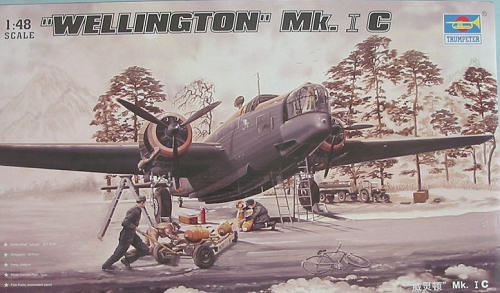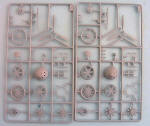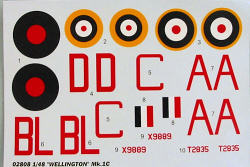
| KIT: | Trumpeter 1/48 Wellington IC |
| KIT #: | ? |
| PRICE: | $109.95 MSRP |
| DECALS: | Two options |
| REVIEWER: | Tom Cleaver |
| NOTES: |

| HISTORY |
Designed to a specification for a heavy bomber first issued in 1932, the first Wellington prototype flew in 1934. It was the second airplane to use the revolutionary geodetic construction system first created by Barnes Wallis for the R-100 airship in the early 1920s. This lightweight construction method made the resulting airplane extremely strong and resistant to structural damage, which was greatly appreciated by crews during the Second World War when the Wellington returned with battle damage that would have downed any other airplane. The geodetic construction allowed the weight of the airplane to grow from 21,000 pounds to 36,500 pounds with no major change in the basic airframe.
William Green described the Wellington thus in his book “Famous Bombers of the Second World War, Vol. 2":
“Few if any bombers of the Second World War enjoyed a longer or more distinguished operational career than the Vickers Wellington. Blooded in combat at the very outset of hostilities,
it carried the lion’s share of Bomber Command’s night bombing offensive until the operational debut of the four engined heavies and was still first-line equipment when the war ended. Indeed, such was the brilliant battle record of the Wellington that any tribute can be but a pale reflection of the distinctions that this remarkable warplane won for itself.”
The first bomber to carry power-operated gun turrets and prove their worth, the Wellington also proved that unescorted bombers could not survive in daylight against determined fighter opposition.
The two major sub-types of the Wellington were the Mk. IC and the Mk.III, though the Mk. X - a Mk.III with American Pratt and Whitney engines - was the type most-produced, with over 3,500 coming out of the factories between 1943 and the end of the war. Production from the three factories totaled 11,461,making the Wellington the most-produced single bomber type used by the RAF.
In addition to its outstanding work in the European Theatre, the Wellington served with distinction in the Middle East and the China-Burma-India Theatre. It also became a major workhorse for Coastal Command in the antisubmarine war during the Battle of the Atlantic.
| THE KIT |
To my knowledge, there has never been a 1/48 Wellington released in any media before this kit from Trumpeter. The kit portrays the first major wartime version, the Mk. IC, and will be followed later this year by the Mk.III.
 The
kit has fourteen parts trees in light gray styrene (your editor has shown two as
representative of the detail level. Ed) and two trees in clear
styrene. One fret of photo-etched parts provides the inner walls of the main
wheel wells. White metal landing gear struts are provided for the main gear and
the tail wheel. The wheel hubs are styrene, and the tires are rubber.
The
kit has fourteen parts trees in light gray styrene (your editor has shown two as
representative of the detail level. Ed) and two trees in clear
styrene. One fret of photo-etched parts provides the inner walls of the main
wheel wells. White metal landing gear struts are provided for the main gear and
the tail wheel. The wheel hubs are styrene, and the tires are rubber.
 The
kit provides a detailed interior that does not just include the cockpit, but the
whole interior, which will be very visible through the very clear windows along
the fuselage sides. A well-detailed bomb bay can put to use the three trees of
bombs that provide all of the early RAF bombs, including 2,000 lb AP, 1,000 lb
GP, 500 lb GP, 500 lb SAP, 250 lb SAP, 250 lb B, and 250 lb GP. The instructions
show seven different load options. There are 30 doors for the bomb bay if you
choose to display it open, though there is also the option of one single part to
close it up.
The
kit provides a detailed interior that does not just include the cockpit, but the
whole interior, which will be very visible through the very clear windows along
the fuselage sides. A well-detailed bomb bay can put to use the three trees of
bombs that provide all of the early RAF bombs, including 2,000 lb AP, 1,000 lb
GP, 500 lb GP, 500 lb SAP, 250 lb SAP, 250 lb B, and 250 lb GP. The instructions
show seven different load options. There are 30 doors for the bomb bay if you
choose to display it open, though there is also the option of one single part to
close it up.
As with other Trumpeter kits, the engines are super-detailed models on their own, in this case they are Pegasus XVIIIs, and the kit provides open or closed cowl flaps. If the flaps are opened, there is plenty of detail inside. Also, positionable flight control surfaces and landing flaps are provided.
 The
decals are the least part of the kit, being too bright in color, though one of
the markings is for the 75 Squadron Wellington in which Sgt. J.A. Ward won the
VC, the only one awarded a Wellington crewmember during the war. Fortunately,
Xtradecal has released a very good sheet for the Wellington that has markings
for three different aircraft in the correct colors and also provides information
for the two different camouflage patterns used on the Wellington. The sheet is
available now from Hannant’s and is highly recommended - I will be using it in
the coming full-build review.
The
decals are the least part of the kit, being too bright in color, though one of
the markings is for the 75 Squadron Wellington in which Sgt. J.A. Ward won the
VC, the only one awarded a Wellington crewmember during the war. Fortunately,
Xtradecal has released a very good sheet for the Wellington that has markings
for three different aircraft in the correct colors and also provides information
for the two different camouflage patterns used on the Wellington. The sheet is
available now from Hannant’s and is highly recommended - I will be using it in
the coming full-build review.
Since the most noteworthy feature about the Wellington is the geodetic construction, it is good that this lattice-type framework has been captured in the kit. Certain “hex-spurts” have complained that the surface detail of this kit is vastly overdone, and have labeled it “unbuildable” as a result. The fact is, it is overdone - personally, I wish the Trumpeter designers had had the opportunity to look at the new Classic Airframes Anson when they were creating this kit, since that kit has some of the more realistic fabric detail I have seen recently. But why the muddlers have chosen now to complain about “overdone detail” on plastic kits is beyond me, given the fact that there is no plastic model airplane kit that does not have overdone detail! The new Eduard World War I models everyone lauds are among the worst offenders with their overdone rib tapes, yet no one complains about them! If “overdone surface detail” is a problem for you, find another hobby - you’re going to be continually disappointed! If you don’t like the surface detail here, go buy one of the many other 1/48 Wellington kits out there.
Additionally, other “hex-spurts” have declared that Trumpeter got it wrong with the cockpit detail, since dual controls are provided. These highly-knowledgeable individuals have declared that Trumpeter must have followed the two surviving Wellingtons, which were used as trainers, where dual controls must have been added on at some point, since “all British bombers only ever had one pilot.” So please tell me, what exactly was F/Sgt. J.A. Ward, RNZAF, doing back in 1941, when he won his Victoria Cross while filling the crew position of second pilot? In point of fact, only the Wellington I had a single pilot. Starting with the Wellington IA, the crew was increased from five to six, with the sixth crewman being the “second pilot,” a position also known as “co-pilot” in American parlance, and a crewmember who had controls to operate.
| CONCLUSIONS |
Let the muddle-duddlers go doodle themselves (it’s what they do best). The kit is accurate, highly detailed, and will build up into an impressive model. From the photos of completed models I have seen, the “overdone surface detail” looks fine under that well-known “coat of paint.”
I’ve wanted a good Wellington in 1/48 for a very long time, and this one fills my bill. I’m sure it will look very nice sitting next to my B-24, B-17, Catalina, Lancaster, He-177 and Betty. Highly recommended. Buy in confidence.
Thanks to Stevens International for the review kit.
If you would like your product reviewed fairly and quickly by a site that has nearly 325,000 visitors a month, please contact me or see other details in the Note to Contributors.